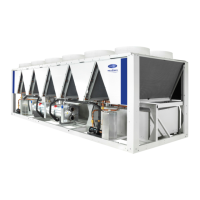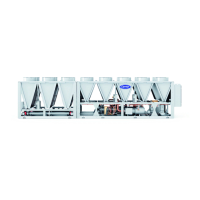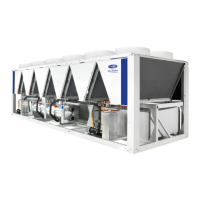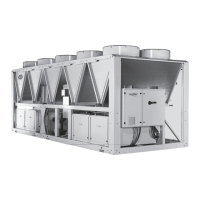35
DUAL CHILLER PUMP CONTROL FOR PARALLEL
CHILLER APPLICATIONS
Parallel chiller control with dedicated pumps is recommended.
The chiller must start and stop its own water pump located in
its own piping. If pumps are not dedicated for each chiller’s
piping, chiller isolation valves are required; each chiller must
open and close its own isolation valve through the control. Fig-
ures 32-35 show typical pump arrangements for dual chiller
parallel applications.
Although not recommended, it is possible to configure the sys-
tem with no individual pump control. In applications where the
unit is configured for fresh water (Main Menu
Configura-
tion Menu
Service Parameters, Evaporator Fluid Type=1
[Fresh Water]), and Set Point temperature is close to the lower
limit of the fresh water range, it is possible for changeable
leaving water conditions as the chilled water flow rate drops to
an operating unit, causing the leaving chilled water tempera-
ture to drop and initiate the evaporator freeze protection over-
ride. Constant flow applications may alleviate this issue.
In constant water flow applications, the master chiller should
be the primary control source for the chilled water pump. The
slave chiller should have override capability. In the event of a
communication failure between the master and slave chillers,
the slave chiller will operate as a stand-alone machine and
therefore must be able to enable the chilled water pump.
DUAL CHILLER CONTROL FOR SERIES CHILLER
APPLICATIONS
When chillers are configured to work in series mode no addi-
tional chilled water supply sensor is required. The master
chiller will be installed downstream of the slave chiller (the
slave chiller outlet fluid is the master inlet fluid). If pump con-
trol is required, it will be controlled by the master chiller.
To configure the master chiller for series applications, see Ta-
ble 28. To configure the slave chiller for series applications,
see Table 29.
Fig. 32 — Typical Parallel Master/Slave Chillers
Dedicated Primary Pumping, Variable Flow, Leaving Water Control
CONTROL BOX
SLAVE
CHILLER
CONTROL BOX
MASTER
CHILLER
LOAD
CHECK VALVES
CHWS TEMP SENSORS
FIELD WIRING
FIELD COMMUNICATION WIRING
SLAVE
PUMP
MASTER
PUMP
NOTE: This is a simplified piping diagram.
Not all hydronic specialties are shown.
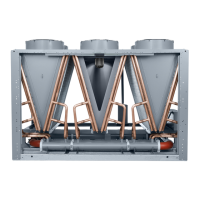
